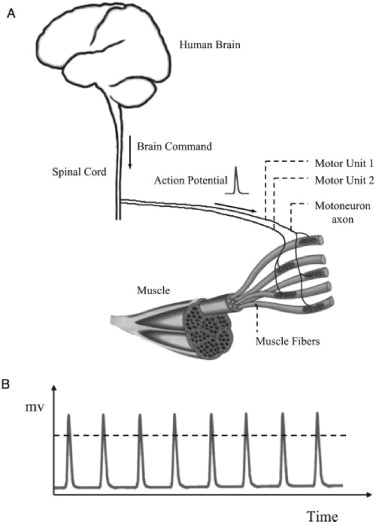Power to many is control, electricity, or strength depending on what one is talking about. But to muscles, it involves all three. When at the gym and thinking that someone looks powerful they usually have a lot of muscle. However, to control or activate all that muscle and use their strength it requires electrical power.
To be more specific muscle activation can be broken down into 3 steps for a muscle to create movement:
- Excitation Signal: An electrical pulse is sent from the brain to the muscle through the nerves.
- Activation Dynamics: After receiving the excitation signals, the muscle activation process begins.
- Contraction Dynamics: The muscle fibers contract, resulting in movement.
This three-step process occurs in less than a second. Understanding these steps allows for a wide range of applications from prosthetic control, to better exercise and physical therapy. Many researchers often focus solely on the first step the excitation signal.
Excitation signals can be consciously sent throughout the body or be sent from outside the body. For voluntary muscle action, the command takes the form of an electrical impulse transmitted from the brain to the spine and the corresponding nerves eventually leading to the muscle fibers they control. After much research scientists found that if the signal exceeds a certain threshold, it then results in an action meaning that once there is a strong enough signal sent the action occurs and the muscles contract and they contract with a strength proportionally strong to the signal. This activation is illustrated in Figure 1.

How is it Measured?
Research in this area focuses on using Electromyography (EMG), which measures electrical activity in response to nerve stimulation of muscles. EMG can be performed invasively by inserting needles into the muscle or noninvasively through skin contact. However, both methods have challenges:
- Invasive EMG: Requires precise insertion of needles into the target muscle.
- Noninvasive EMG: Sensor placement must be exact, and factors like body fat, hair, and sweat can hinder signal accuracy, making long-term use difficult.
Applications of Muscle Activation
Understanding and being able to read these electrical muscle activation signals enables the development of complex exoskeletons, and prosthetics that can be easily controlled by users as the muscles that control the fingers are in the forearms so even if someone doesn’t have a hand the electrical output is still there to be read and control a prosthetic hand. It also allows people to understand and view muscle fatigue during activities. This is done with surface EMGs by viewing the decrease in the maximum output of electrical currents.
This process also works in the opposite direction by sending similar electrical signals from outside the body to activate the muscle for various uses. Such uses are physical therapy to electrical stimulation is a type of physical therapy used to achieve various goals. These goals include strengthening muscles, improving blood circulation, and even helping deter muscle atrophy by activating more of the muscle so it does work than the person can on their own. It can also be used to form different efficient exercise programs (like EMS workouts) where one gets shocked while working out to further stimulate it. Additionally, this knowledge can be used for entertainment purposes like using a computer to control your friends as shown in the YouTube video below.
In summary, this is the first step for muscles to activate leading to more questions for future research currently being conducted, like what are our limits on our understanding of that second stage, and can a new understanding of the second stage be just as or more effective for the same applications?
